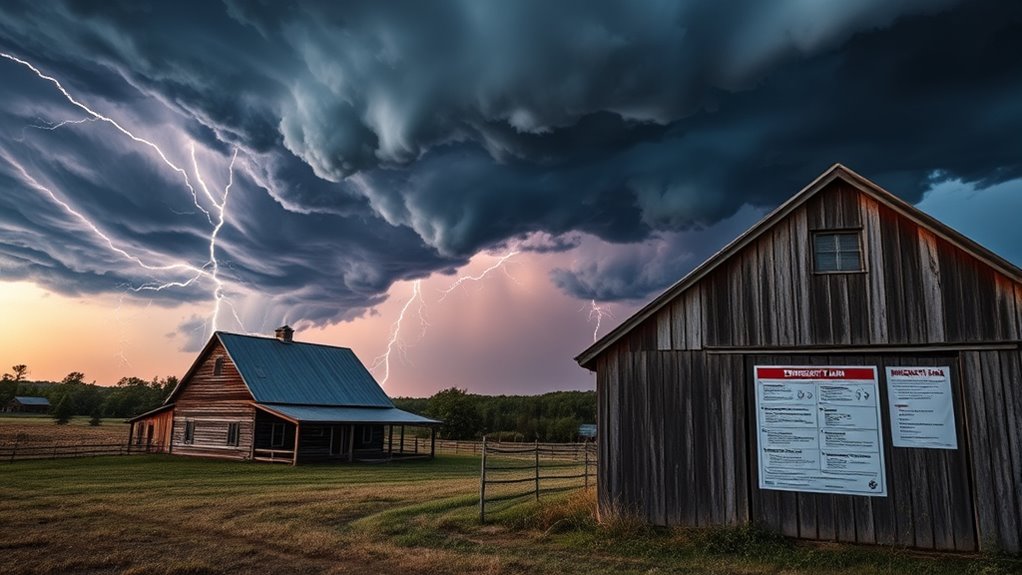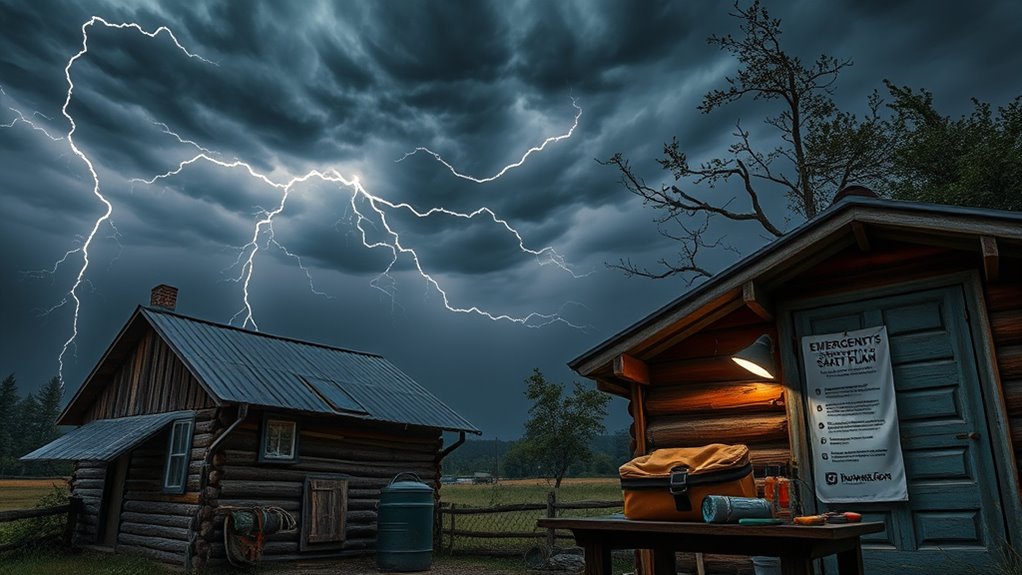To prepare for thunderstorms in your rural home, stay informed by signing up for weather alerts and keeping a battery-powered radio nearby. Identify a safe interior spot on your lowest floor and make certain everyone knows where it is. Stock emergency supplies like flashlights, first aid kits, and backup power for devices. Develop a family communication plan and practice quick sheltering techniques regularly. If you follow these steps, you’ll be better equipped to handle storms safely—and there’s more to learn to boost your preparedness.
Key Takeaways
- Identify and communicate a safe, interior shelter location on the lowest floor before storms arrive.
- Sign up for and monitor local weather alerts via radio, mobile apps, or NOAA Weather Radio.
- Prepare an emergency kit with flashlights, batteries, first aid supplies, and essential medications in an accessible area.
- Establish family communication plans and a designated meeting point outside the home.
- Conduct regular drills to ensure everyone knows storm procedures and emergency supplies are ready.

When a thunderstorm strikes rural areas, having a solid emergency plan can mean the difference between safety and disaster. You need to be prepared to respond quickly, especially since rural settings often lack immediate access to emergency services. The first step in your plan should be understanding storm safety and how to interpret weather alerts. Stay informed by signing up for local weather alerts through radio, mobile apps, or NOAA Weather Radio. These alerts will notify you of approaching storms, giving you vital time to prepare or seek shelter. Remember, weather alerts are your best early warning system, so keep a battery-powered weather radio in a central, accessible location at all times.
Stay informed with weather alerts via radio, apps, or NOAA Weather Radio to ensure safety during rural thunderstorms.
To guarantee storm safety, identify the safest location in your home where you can take shelter during a thunderstorm, ideally a small interior room on the lowest floor away from windows. Avoid areas like open porches, garages, or sheds, which provide little protection from lightning, hail, or strong winds. Make sure everyone in your household knows where to go and how to reach this safe space quickly. Keep emergency supplies nearby, including flashlights, batteries, a first aid kit, and essential medications. These will be invaluable if the storm causes power outages or other disruptions.
Preparation also involves creating a communication plan. Decide on a family meeting point outside your home where everyone can gather after the storm passes. Ensure all members know how to contact each other if separated, especially if cell service becomes unreliable. It’s wise to have a backup power source for your cell phones and other critical devices. During storm safety, avoid using landline phones to prevent potential electrical hazards if lightning strikes nearby. Instead, rely on mobile devices and ensure they are fully charged before storms arrive.
Practicing your emergency plan regularly is key. Conduct drills to help everyone understand what to do when weather alerts are issued. This not only builds confidence but also reduces panic during actual storms. Keep your emergency kit stocked and check that your weather alert systems are functioning properly. Remember, the goal is to act swiftly and decisively when the weather alerts indicate a thunderstorm is imminent. Having a well-practiced plan will make it easier to stay calm, safe, and in control when severe weather hits your rural property.
Frequently Asked Questions
How Can I Detect an Approaching Thunderstorm Early?
You can detect an approaching thunderstorm early by keeping an eye on weather monitoring updates and listening for alerts from early warning systems. Stay tuned to local weather radio, apps, or websites that provide real-time storm tracking. Watching for darkening skies, sudden drops in temperature, and increasing wind can also signal an imminent storm. Being proactive with weather awareness helps you prepare and stay safe in rural areas.
What Materials Are Best for Building a Storm-Safe Shelter?
You should use storm-resistant materials like reinforced concrete, steel, or brick for your shelter, as they offer maximum protection. When designing your shelter, consider features like a sturdy roof, minimal windows, and proper ventilation. Guarantee it’s well-anchored and built below ground level if possible. These shelter design considerations help withstand high winds, hail, and flying debris, providing safety during thunderstorms.
How Often Should I Review and Update My Emergency Plan?
Think of your emergency plan as a garden that needs regular tending. You should review it at least once a year, especially before thunderstorm season, to make certain it’s still effective. Regular review and plan updates keep you prepared for changing weather patterns and new risks. By staying proactive, you safeguard your loved ones and property, just as a gardener nurtures their plants to ensure a fruitful, safe harvest every season.
Are There Specific Signs That Indicate a Tornado During a Thunderstorm?
You can spot signs of tornado formation by paying attention to storm warning signs like a dark, rotating cloud, a loud roar resembling a freight train, or a visible funnel cloud. During a thunderstorm, stay alert for changes in wind speed and direction, as these indicate a possible tornado. If you notice any of these signs, seek shelter immediately and follow your emergency plan to stay safe.
What Should I Include in a Portable Emergency Kit for Storms?
For storm safety and emergency preparedness, your portable emergency kit should include essentials like water, non-perishable food, a flashlight, batteries, a first aid kit, and necessary medications. Add a whistle for signaling, a portable phone charger, and warm clothing. Don’t forget important documents and some cash. Keep the kit in an accessible location, so you’re ready to respond quickly during storms and stay safe in emergencies.
Conclusion
Remember, having a thunderstorm emergency plan isn’t just about safety — it’s about being prepared when nature surprises you. Sometimes, a sudden storm can strike just as you’re tending to daily chores, reminding you that life’s unpredictability is always lurking nearby. By staying alert and planning ahead, you’re not only protecting your home but also embracing the quiet moments of calm that follow. After all, preparedness often emerges from the most unexpected coincidences.










